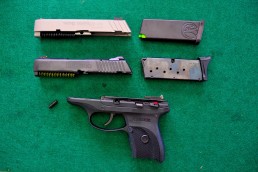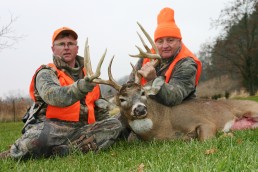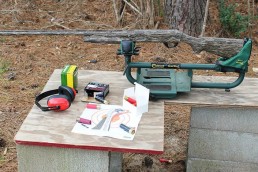The 3-in-1 Gun
SHARE THIS POST
There are a few guns on the market that can be converted to another type of ammunition through switching out barrels and cylinders, but not that many that can go three ways. Ruger’s LC380 is one of these that can become three guns in one. The LC380 can be converted to a LC9 (9mm) or a LC22 (22 caliber) with the right kits. Ruger has the kit that converts it to the LC9, but a company called Twisted Industries has designed one that converts it to the LC22. Making it into the “LC380” is easy too, at least with the “Twisted” LC22. I haven’t experienced the LC9 conversion, but from all indications, it’s just as easy.
To covert this gun, the takedown pin is removed and then the slide assembly with the barrel and spring is slid off, going forward. The LC22 assembly is then slid on, but brought back to the point of where the slide is locked open. That is where there is a difference; the takedown pin has to go through a notch and positioned farther forward on the 22’s slide. Once the pin is inserted, close the takedown plate and unlock and close the slide. It’s now ready to go—it’s that simple.
The magazines for the two are a little different. While the LC380’s 7-round capacity magazines pop in and out easily, the LC22 takes more effort. However, loading the ammunition in the LC22’s 10-round capacity magazines is next to no effort, whereas the LC380’s work takes a bit of pushing.
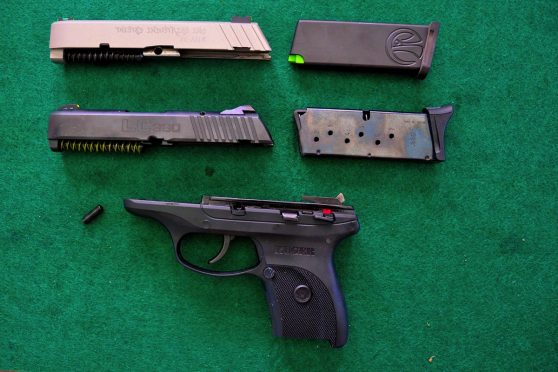
Sights on the LC380 are small white dots, and I do mean small. I countered this by repainting them with Glow-On to save the expense of purchasing fiber-optic sights. And, the rear sight is adjustable for windage. The LC22’s sights are very nice fiber optic, which can be ordered in any color or color combination. I opted for all with a fluorescent green on front and back. These are not adjustable, but I was able to push it a little to the side when I removed the screw that holds the sight in place. I then replaced the screw without it moving back.
Another difference between the two guns is the “loaded chamber indicator,” which is on top of the LC380’s slide, but not on the LC22. This is a bar that sticks up if there’s a round in the chamber.
Vanessa Perry of Strum/Ruger & Company knows about the accuracy of the LC380 gun.
“The LC9/LC380 pistols are designed to shoot a 2-inch grouping from 10 yards,” Perry said. “This is about as far as you would expect with the pistol’s shorter 3.12-inch barrel, and overall length of 6 inches.”
Are you enjoying this post?
You can be among the first to get the latest info on where to go, what to use and how to use it!
She added that Ruger does not have any recommendations for ammunition.
Twisted Industries tests their LC22 with a CCI Mini Mag, so that is the likely recommendation.
The 380’s weight is at 17.2 ounces, but the LC22 conversion is lightweight enough that it drops the overall weight of the gun to around 6 ounces. I was extremely surprised and pleased at the difference.
Depending on the options you select on the conversion kit, with added optic sights it will cost between $240 to $280, or you can get the base kit at $200. A magazine comes with the kit, but I recommend having a couple of spares.
For test-firing the LC380, I used three types of ammunition: Magtech LRN, Geco FMJ and Fiocchi FMJ. All were at 95 grain. On the LC22, I used four types of 40-grain ammunition: Remington Thunderbolt at 1,255 fps, Federal Premium 719 HV Match at 1,200 fps, Federal Premium 720 Hunter Match at 1,200 fps and Federal 729 Rimfire at 1,200 fps. The results for the LC380 were not great, and I had several strange jams where the rounds were sticking straight up or sideways with the slide closed. However, these were all with the Magtech and Geco. I’ve had jams in the past with the Magtech when fired in a Browning 1911-380, but this was the first time I had used the Geco. The Fiocchi performed the best, hitting the 2- and 4-inch bull’s-eye on a pistol target. It had some high shots, but that was done when trying to compensate for the lower shots I had with the other ammo. Once I saw that it was hitting higher, I then adjusted my aim to my “normal” way and hit the center area.
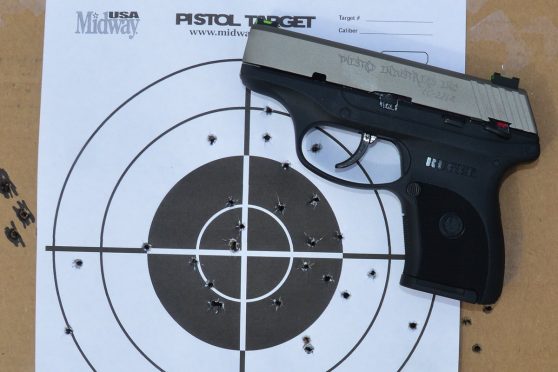
Twisted Industries’ LC22 performed very well with just about all the ammunition, but if there was an edge it would be given to the Thunderbolt and Hunter Match. I started shooting to the right but found that the rear sight was slightly off—the adjustment for which was discussed above. It has not been fired after that time, but with the performance already found I’m sure it will help immsensely with the accuracy.
For anyone who wants a small, easily concealable 3-in-1 pistol, I would definitely take a look at Ruger’s LC380 then get a Twisted Industries LC22 conversion. The LC22 will save money on ammunition for practicing as well as provide the shooter with a very lightweight gun that’s fun to shoot. In fact, you may find that you will want to leave it as a 22. The LC9 conversion can wait if you’d like, as there isn’t that much difference from the 380. But I still hope to get one at some point, if for no other reason than to try it for another demonstration video or article. And, I know it eats slightly cheaper ammo than the 380.
MWO
SHARE THIS POST
Did you enjoy this post?
You can be among the first to get the latest info on where to go, what to use and how to use it!
Dan Galusha
Dan Galusha has fished all of his life, worked more than 45 years in the outdoor/media industry, and was inducted into the Fresh Water Fishing Hall of Fame as a Legendary Communicator. Direct questions through dansfishntales.com, facebook.com/dansfishntales and facebook.com/shootnplink.
